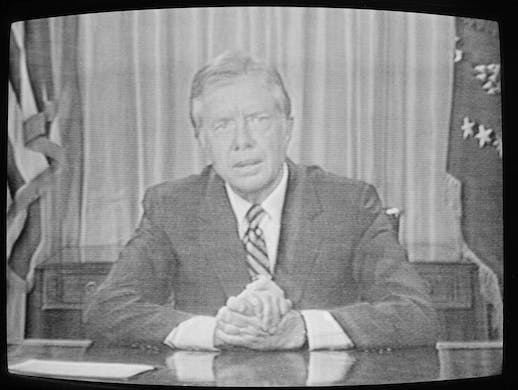Welcome to Jimmy Carter’s Second Term: It’s Worse Than the First
President Biden now seems bent on emulating Carter, and he’s not even doing that very well.

President Carter’s dreary four years in the White House discredited the Democratic Party for a generation. After he left, it took Democrats 12 years to win the presidency again, and only with a candidate — Bill Clinton — who couldn’t have been more different than the party-pooping preacher from Plains.
Regardless, President Biden now seems bent on emulating Mr. Carter, and he’s not even doing that very well. His approval rating has tracked Mr. Carter’s in downward trajectory, but it’s significantly worse: 40 percent compared to 52 percent at the same point in their presidencies.
More ominous, inflation is now rising faster than at any point in Mr. Carter’s presidency, which was dominated and ultimately doomed by the losing struggle against rising prices. Inflation in Mr. Carter’s first year was 6.5 percent, up from 5.7 percent the previous year. In Mr. Biden’s first year, inflation was 7.0 percent, up from just 1.2 percent the previous year.
In fact, the comparison is unfair to Mr. Carter, who was after all a nuclear engineer with an elementary understanding of economics.
Mr. Carter understood that there was too much money chasing too little productivity, producing the combination of inflation, unemployment, and stagnant growth called “stagflation,” in which wage gains were immediately wiped out by higher prices for consumers.
He came to office proposing to restrain wage increases and tighten price controls, but these measures only produced shortages and angry labor unions. By the middle of his second year in office, Mr. Carter accepted that there was no alternative to a policy of fiscal and monetary restraint.
So he proposed a balanced budget with deep cuts to social and environmental programs. He also nominated as chairman of the Federal Reserve a conservative economist, Paul Volcker, who thought interest rates should go as high as necessary to tame inflation.
Just as important, Mr. Carter worked hard to relieve the regulatory burdens on business. He freed America’s airline industry, paving the way for the most efficient and affordable airline travel in the world, and streamlined environmental regulations. He also championed free trade.
In embracing such free-market policies, Mr. Carter in effect wrote off the left wing of his party, which was deeply opposed to them. That was a different era: Even the New York Times recognized the need to rein in government and embrace free markets.
Under Mr. Carter, interest rates hit 20 percent, the highest level in modern times. His policies were the right antidote to inflation, but they produced a steep recession, and all but guaranteed Ronald Reagan’s electoral victory in 1980.
Mr. Biden, meanwhile, seems not to have accepted the reality facing America today. Inflation accelerated in January, reaching 7.5 percent. Worse, the producer price index, which drives consumer prices, shot up more than 10 percent at the end of 2021, with consequences that have yet to materialize.
Mr. Biden appears genuinely unaware that his party’s dramatic expansion of unemployment benefits during the pandemic fueled consumption while killing job-creation at the very moment that increased labor productivity was most needed. Even more baffling, he blames inflation on the resulting supply-chain crisis, which is like blaming inflation on inflation.
The White House press secretary, Jen Psaki, recently seemed stunned by the suggestion that higher producer prices might be passed on to consumers, a shocking display of economic illiteracy at the highest levels of the White House.
In fact the administration is doubling down on the very policies that created the supply-chain and inflationary crises in the first place. Mr. Biden is now insisting that his Build Back Better plan would alleviate inflation by injecting $3.5 trillion more of borrowed money into the economy. Yet without fiscal discipline, the needed tightening would have to come from the Fed in the form of much higher interest rates, which in turn could double or even triple the interest payments on our national debt.
By the time Reagan became president, left-wing policies had been discredited in much of the developed world. A broad consensus in favor of low taxation, low regulation, and free trade opened the door to the greatest peacetime economic expansion in American history.
Mr. Biden may not be willing to suffer the political consequences of the painful measures we need now, but political consequences are coming anyway. Last November in Virginia, which Mr. Biden had won by 10 points just a year before, Republicans swept the statewide offices.
The Democrats’ embrace of critical race theory in schools, the BLM agenda on voting integrity, Covid mandates, profligate spending, and other radical left-wing policies are heralds of electoral catastrophes to come.
There is one way in which Mr. Biden resembles the president from Plains: He is well on his way to discrediting the Democratic Party for another generation.

